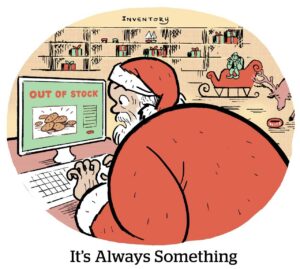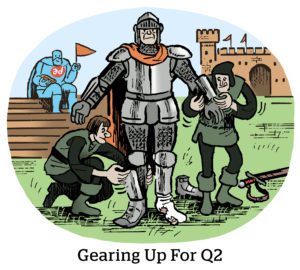Hey Readers,
Welcome back to AdExchanger’s Commerce Media newsletter.
This week, we’re looking at retail media but from a different point of view: the Wall Street perspective.
Programmatic and the real nuances of data-driven marketing are not necessarily important for the CEOs and CFOs of big retailers to know.
Although the word “advertising” has crept onto some balance sheets and earnings reports – Amazon now discloses ad revenue every quarter, while Walmart and Target do so once per year – retail media looks a little different to executives at that level.
For CFOs and investors, the explosion of retail media is one part of a much larger, more perilous transition from focusing on OpEx (operating expenses) to focusing more on CapEx (capital expenditures).
In the retail media context, CapEx investments (think automation and information services) come with higher profit margins than OpEx investments, like store wages and product pricing power. Prioritizing CapEx can help a physical retail business survive on rock-bottom profit margins or even at a loss.
AdExchanger spoke with Steven Shemesh, the retail and CPG industry equity analyst for RBC Capital Markets, to get his thoughts on the industry’s newest buzzword – which isn’t retail media but “CapEx growth.”
AdExchanger: Why are we seeing such rapid growth of retailer-owned data and advertising businesses?
STEVEN SHEMESH: Historically, all of these retailers have operated as clothiers and general merchandise retailers. They buy inventory, manage margin, manage shipping costs, etc., and that’s what their profit margin is made up of.
Walmart has changed its tack as of late. They’re pivoting from more of an OpEx investment cycle, when they were invested in wages and price, to a CapEx investment cycle, where they’re investing in automation, AI and predictive analytics. Those businesses have higher returns, which basically allows Walmart to invest in the core business while also growing margins.
Retail is shifting online. But ecommerce has lower margin, so, inherently, margin should erode over time as ecommerce penetration increases. [Delivering an order to someone’s home costs more than if shoppers come to your store to purchase or pick up.]
Is that margin constriction inevitable?
If you have a growing advertising business, a growing marketplace business or membership income, those are recurring revenues that can come in at a high margin. Then a business might be able to effectively invest in their core supply chain and logistics network and not have to raise prices.
This is a big focus for Walmart and the buzzword of the retail industry right now. Walmart and Target are probably the furthest along, but Chewy, Best Buy and all sorts of other retailers are looking for ways to leverage advertising to offset the margin costs of higher ecommerce penetration.
Does it take Walmart’s or Target’s level of scale for that transformation to be feasible?
Margins are generally under pressure across the board, and companies like Walmart, Target, Costco and Amazon are best positioned to succeed because they have the most scale and the most customer data.
There are opportunities on a smaller scale in more niche areas to develop these businesses, but they won’t be anything close to, for example, Walmart’s $3.4 billion in advertising revenue or the $1.5 billion that Target has through its Roundel business.
 Do you see more retailers becoming media and entertainment companies, like how Amazon has real studio production?
Do you see more retailers becoming media and entertainment companies, like how Amazon has real studio production?
It’s very possible.
Walmart has a deal with Paramount+. I don’t know what the economics look like of that promotional partnership, but it’s a mechanism for them to help grow their Walmart+ membership share.
They’ve toyed around with creating content to a degree and done some original production. Recently, they recreated a Mean Girls short video. But that’s more toying around with it right now from a marketing perspective.
Walmart also just announced its decision to acquire Vizio, the TV manufacturer. Owning that brand means they can sell TVs at a lower price, but what they’re really trying to do is leverage that operating system to build out their advertising business.
And that likely leads to further investments in CTV.
That Paramount deal really underscored for me how a big retailer can flex here. Broadcasters go through painful carriage disputes over $6 from a monthly subscription – which is the cost of Paramount+ with ads. Walmart happily covers that. At $6 a pop, they can just say, “Give me a million more.”
At the end of the day, this is a market share and scale game, right?
The industry is evolving, and whoever gets a first-mover’s advantage will likely have that advantage for a very long time.
Amazon was quick out of the gate and gained a lot of market share, because it didn’t have to play by the same rules as everyone else. They lost money on packages, because they had other high-margin businesses like AWS and advertising to offset those losses. They were able to keep prices pretty low and invest in a logistics network and last-mile delivery. Amazon ran at a loss on those physical supply-chain businesses, but was still able to turn a profit overall.
What about Walmart?
Walmart made the decision to invest in automation and delivery. I recently saw a new facility in Tampa – a 1.2-million-square-foot distribution center – that’s largely automated. Walmart is investing in logistics to get things from distribution centers onto trucks so they can be easily unpacked in a specific grocery aisle. That saves a great deal of time for workers and improves the customer experience.
As Walmart makes those investments, it should regain market share.
And, meanwhile, all of that feeds into the beast that is advertising, because the more customers you have and the more data you have, the more opportunities you have to reach that consumer before a purchase.
This interview has been lightly edited and condensed.




















